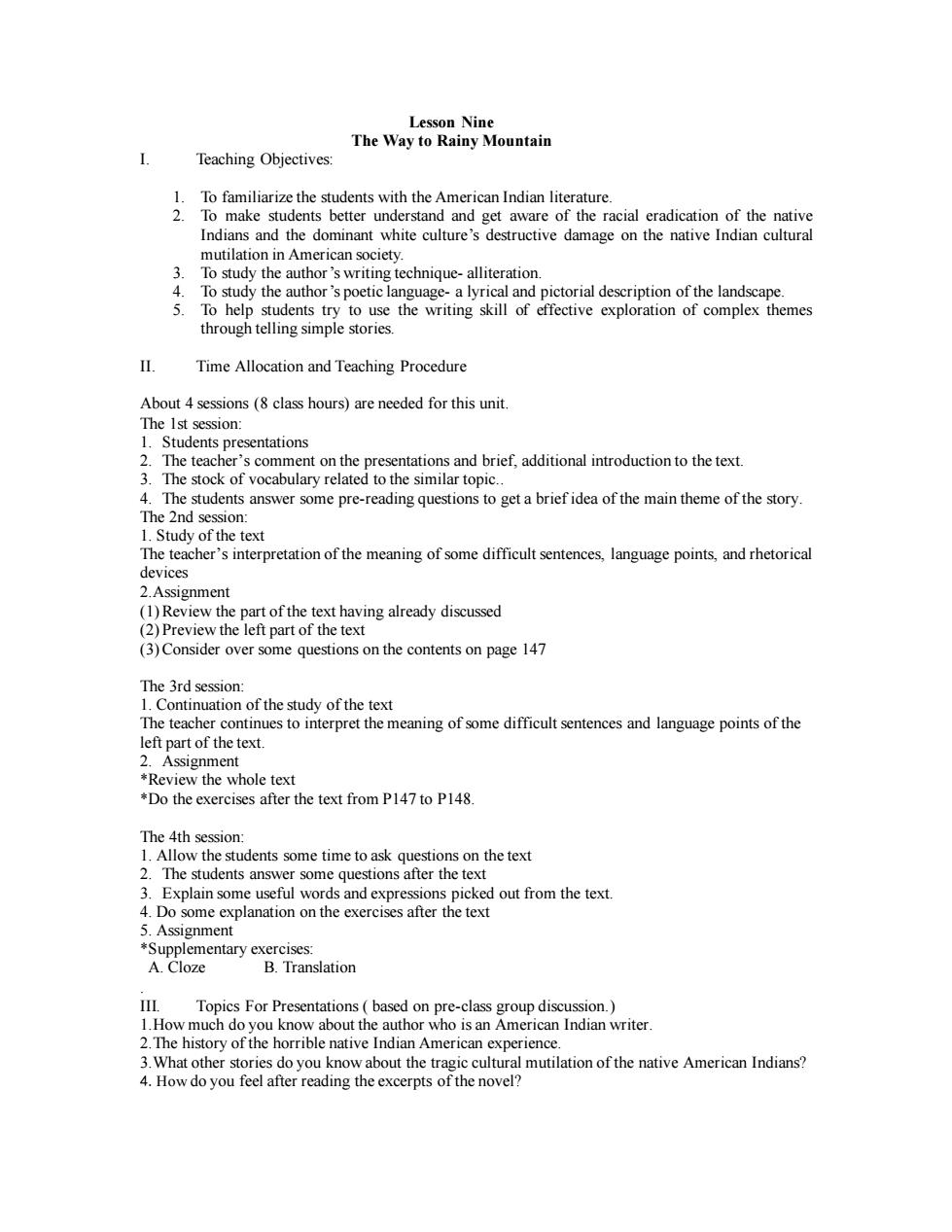
Lesson Nine The Way to Rainy Mountain Teaching Objectives 1.To familiarize the students with the American Indian literature. ts better un 3.To study the author's torial des through telling simple stories. u. Time Allocation and Teaching Procedure About 4 sessions (8 class hours)are needed for this unit. The Ist session: ents presentations sand the text 3.The stock of vocabulary related to the similar topic. 4.The students answer some pre-reading questions to get a briefidea of the main theme of the story. The teacher's interpretation of the meaning of some difficult sentences,language points,and rhetorical devices ()preve the o he ereaydiced 1) part ofthe (3)Consider over some questions on the contents on page 147 The 3rd session 1.Continuation of the study of the text The teach tointerpret the meaning ofme diffcutand languge pointsofthe ent *Review the whole text Do the exercises after the text from P147to P148 The 4th session 1.Allow the students some time to ask questions on the text The students answ er some questions alter the tex ed out from the text 5.Assignment Topics For Presentations(based on pre-class group discussion.) about the hor who is an American Indian writer 3.What other stories do you know about the tragic cultural of the native merican Indians? 4.How do you feel after reading the excerpts of the novel?
Lesson Nine The Way to Rainy Mountain I. Teaching Objectives: 1. To familiarize the students with the American Indian literature. 2. To make students better understand and get aware of the racial eradication of the native Indians and the dominant white culture’s destructive damage on the native Indian cultural mutilation in American society. 3. To study the author’s writing technique- alliteration. 4. To study the author’s poetic language- a lyrical and pictorial description of the landscape. 5. To help students try to use the writing skill of effective exploration of complex themes through telling simple stories. II. Time Allocation and Teaching Procedure About 4 sessions (8 class hours) are needed for this unit. The 1st session: 1. Students presentations 2. The teacher’s comment on the presentations and brief, additional introduction to the text. 3. The stock of vocabulary related to the similar topic. 4. The students answer some pre-reading questions to get a brief idea of the main theme of the story. The 2nd session: 1. Study of the text The teacher’s interpretation of the meaning of some difficult sentences, language points, and rhetorical devices 2.Assignment (1) Review the part of the text having already discussed (2) Preview the left part of the text (3) Consider over some questions on the contents on page 147 The 3rd session: 1. Continuation of the study of the text The teacher continues to interpret the meaning of some difficult sentences and language points of the left part of the text. 2. Assignment *Review the whole text *Do the exercises after the text from P147 to P148. The 4th session: 1. Allow the students some time to ask questions on the text 2. The students answer some questions after the text 3. Explain some useful words and expressions picked out from the text. 4. Do some explanation on the exercises after the text 5. Assignment *Supplementary exercises: A. Cloze B. Translation . III. Topics For Presentations ( based on pre-class group discussion.) 1.How much do you know about the author who is an American Indian writer. 2.The history of the horrible native Indian American experience. 3.What other stories do you know about the tragic cultural mutilation of the native American Indians? 4.How do you feel after reading the excerpts of the novel?
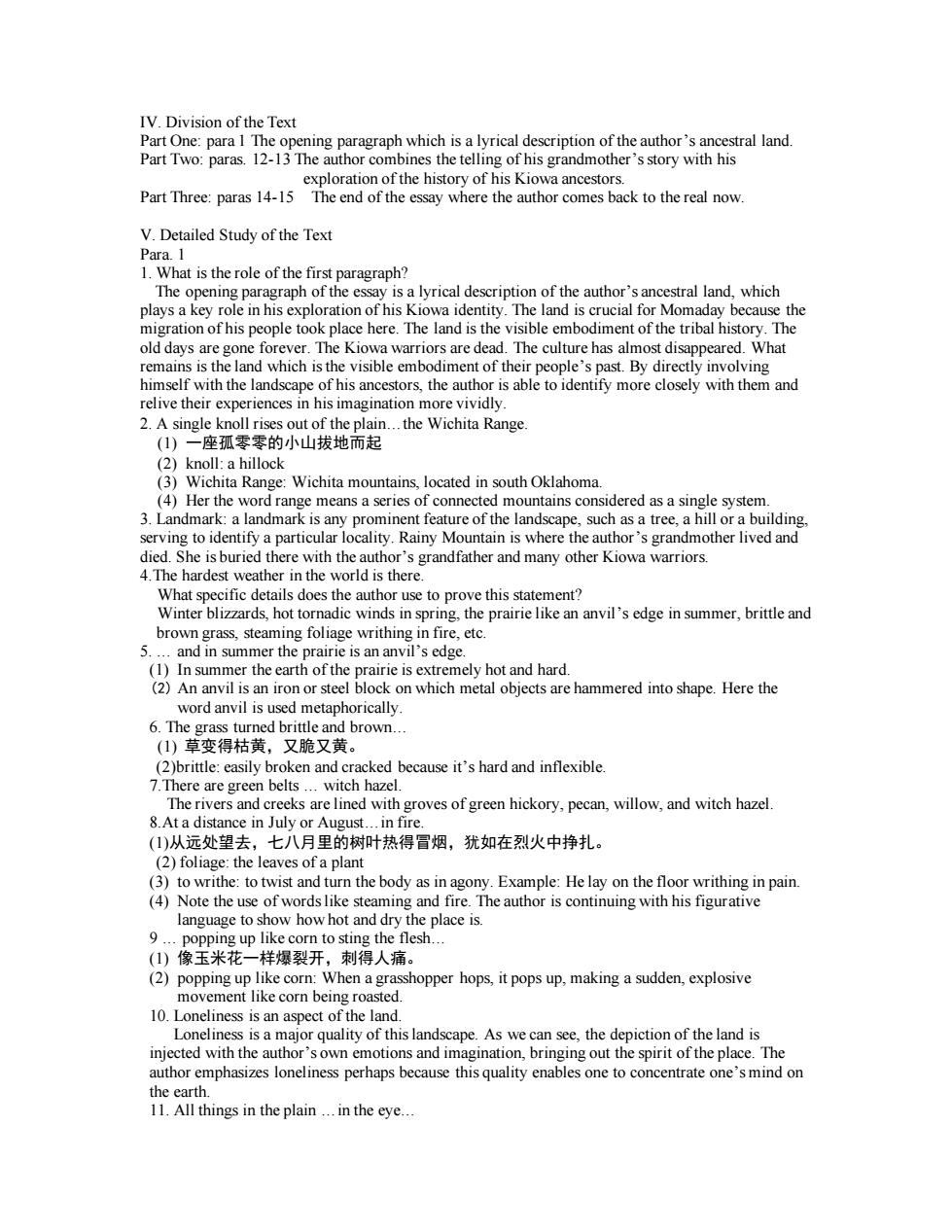
IV Division agraph which is a lyrical descrintion of the author's stral land. Part Two:paras.12-13 The author combines the telling of his grandmother's story with his Pat thep4-15otheeo V Detailed Study of the Text Para.1 1.What is the role of the first paragraph? The opening paragraph of the ess nle eThe land is the e visible old days are g rone forever.The Kiowa warriors are dead.The culture has almost dis eared What which is the visible embodiment of their people's past.By directly involving t the ors,the auth r is able to identify more closely with them and of the ()一座孤零零的小山拔地而起 ain.the Wichita R nge (2)knoll:a hillock (3)Wichita Range:Wichita mountains,located in south Oklahoma Her the word range e means a series of connected mountains cons dered as a single system erving to identify a nar ndmother lived and died.She is buried there with the author's grandfather and many other Kiowa warriors 4.The hardest weather in the world is there s does the author use to prove this statement e prairie like an anvil's edge in summer,brittle and and in summer the prairie is an anvil's edge prairie hot and hard an iron or ste on which metal objects are hammered into shape.Here the ord anvil )草变得枯黄,又脆又黄。 (2)brittle:easily broken and cracked because it's hard and inflexible 7.There are green belts witch hazel. The rivers and ks are line groves of green hickory,pecan,willow,and witch hazel O A 从远处望去! 八月里的树叶热得冒烟,犹如在烈火中挣扎 (foliag the (3)to writhe:to twist and turn the body as in agony.Example:He lay on the floor writhing in pain (4)Note the use of wordslike steaming and fire.The author is continuing with his figurative language to s show how ho and dry the place is. 样裂 得人 movement like corn being roasted. opper hops,it pops up,making a sudden,explosive 10.Loneliness is an aspect of the land. Loneliness is a major quality of this landscape.As we can see,the depiction of the land is bes an he pl sone to concentrate one's mind on 11.All things in the plain.in the eye
IV. Division of the Text Part One: para 1 The opening paragraph which is a lyrical description of the author’s ancestral land. Part Two: paras. 12-13 The author combines the telling of his grandmother’s story with his exploration of the history of his Kiowa ancestors. Part Three: paras 14-15 The end of the essay where the author comes back to the real now. V. Detailed Study of the Text Para. 1 1. What is the role of the first paragraph? The opening paragraph of the essay is a lyrical description of the author’s ancestral land, which plays a key role in his exploration of his Kiowa identity. The land is crucial for Momaday because the migration of his people took place here. The land is the visible embodiment of the tribal history. The old days are gone forever. The Kiowa warriors are dead. The culture has almost disappeared. What remains is the land which is the visible embodiment of their people’s past. By directly involving himself with the landscape of his ancestors, the author is able to identify more closely with them and relive their experiences in his imagination more vividly. 2. A single knoll rises out of the plain.the Wichita Range. (1) 一座孤零零的小山拔地而起 (2) knoll: a hillock (3) Wichita Range: Wichita mountains, located in south Oklahoma. (4) Her the word range means a series of connected mountains considered as a single system. 3. Landmark: a landmark is any prominent feature of the landscape, such as a tree, a hill or a building, serving to identify a particular locality. Rainy Mountain is where the author’s grandmother lived and died. She is buried there with the author’s grandfather and many other Kiowa warriors. 4.The hardest weather in the world is there. What specific details does the author use to prove this statement? Winter blizzards, hot tornadic winds in spring, the prairie like an anvil’s edge in summer, brittle and brown grass, steaming foliage writhing in fire, etc. 5. . and in summer the prairie is an anvil’s edge. (1) In summer the earth of the prairie is extremely hot and hard. (2) An anvil is an iron or steel block on which metal objects are hammered into shape. Here the word anvil is used metaphorically. 6. The grass turned brittle and brown. (1) 草变得枯黄,又脆又黄。 (2)brittle: easily broken and cracked because it’s hard and inflexible. 7.There are green belts . witch hazel. The rivers and creeks are lined with groves of green hickory, pecan, willow, and witch hazel. 8.At a distance in July or August.in fire. (1)从远处望去,七八月里的树叶热得冒烟,犹如在烈火中挣扎。 (2) foliage: the leaves of a plant (3) to writhe: to twist and turn the body as in agony. Example: He lay on the floor writhing in pain. (4) Note the use of words like steaming and fire. The author is continuing with his figurative language to show how hot and dry the place is. 9 . popping up like corn to sting the flesh. (1) 像玉米花一样爆裂开,刺得人痛。 (2) popping up like corn: When a grasshopper hops, it pops up, making a sudden, explosive movement like corn being roasted. 10. Loneliness is an aspect of the land. Loneliness is a major quality of this landscape. As we can see, the depiction of the land is injected with the author’s own emotions and imagination, bringing out the spirit of the place. The author emphasizes loneliness perhaps because this quality enables one to concentrate one’s mind on the earth. 11. All things in the plain .in the eye
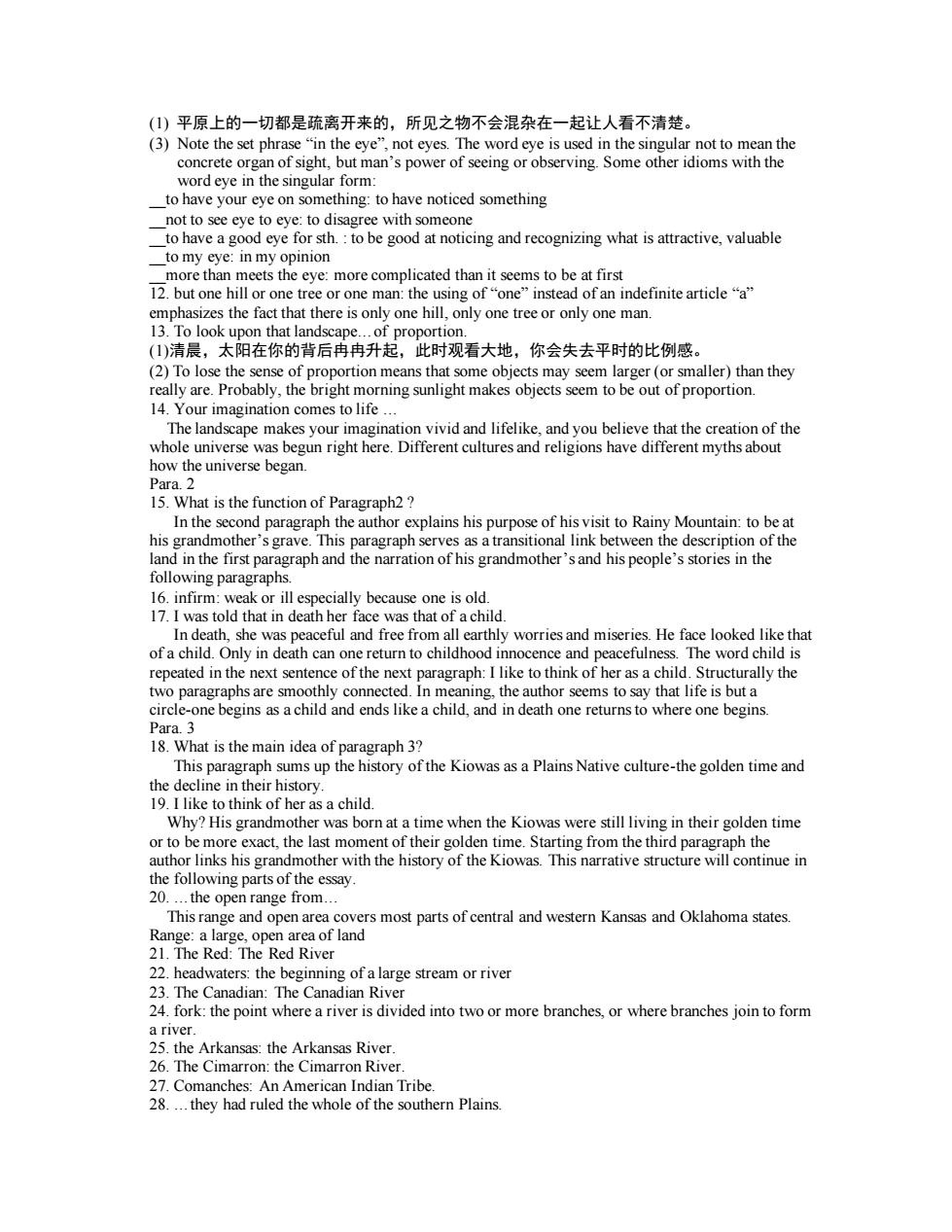
(1)平原上的一切都是疏离开来的,所见之物不会混杂在一起让人看不清楚。 (3)Note the set phrase ut man's power of seeing or observing oms with the to have your eve on something to have noticed something not to see eye to eve:to disagree with someone to have a good eye for sth.:to be good at noticing and recognizing what is attractive,valuable to my eye:in my opinior nlicatod than it to be at firs 12 but one hill or one tree or one man:the using of"one"instead ofan indefinite article" fact that there is only on hill,onyoner 00k at la 阳在你的背后冉冉升起 时现看大地,你会失去平时的比例感 (2)T01 th pronortion means thatoeets seem to be out of pronortion 14 Your im ination comes to life The landscape makes your imagination vivid and lifelike.and you believe that the creation of the whole universe vas begun right here.Different cultures and religions have different myths about Pa e universe began 15.What is the function of Paragraph2? In the second paragraph the author explains his purpose of his visit to Rainy Mountain:to be at tween t m the ti d his people's stores 9sobcnoaoaee ak or ill esnecially hecause one is old ath d that ence an ally th circle-one begins as a child and ends like a child,and in death one returns to where one begins. What is ida of i the decline in their histor as as a Plains Native culture-the golden time and 19.I like to think of her as a child. Why?His grandmoth r was born at a time wh en the Kiowas we living in their golde time m the th nue in the following parts of the ess the open range from. and open are covers most parts of cral and wesern Kansas and Oklahoma sta 22.headwaters:the beginning of a large stream or river cnmore brance or were brde onm
(1) 平原上的一切都是疏离开来的,所见之物不会混杂在一起让人看不清楚。 (3) Note the set phrase “in the eye”, not eyes. The word eye is used in the singular not to mean the concrete organ of sight, but man’s power of seeing or observing. Some other idioms with the word eye in the singular form: _to have your eye on something: to have noticed something _not to see eye to eye: to disagree with someone _to have a good eye for sth. : to be good at noticing and recognizing what is attractive, valuable _to my eye: in my opinion _more than meets the eye: more complicated than it seems to be at first 12. but one hill or one tree or one man: the using of “one” instead of an indefinite article “a” emphasizes the fact that there is only one hill, only one tree or only one man. 13. To look upon that landscape.of proportion. (1)清晨,太阳在你的背后冉冉升起,此时观看大地,你会失去平时的比例感。 (2) To lose the sense of proportion means that some objects may seem larger (or smaller) than they really are. Probably, the bright morning sunlight makes objects seem to be out of proportion. 14. Your imagination comes to life . The landscape makes your imagination vivid and lifelike, and you believe that the creation of the whole universe was begun right here. Different cultures and religions have different myths about how the universe began. Para. 2 15. What is the function of Paragraph2 ? In the second paragraph the author explains his purpose of his visit to Rainy Mountain: to be at his grandmother’s grave. This paragraph serves as a transitional link between the description of the land in the first paragraph and the narration of his grandmother’s and his people’s stories in the following paragraphs. 16. infirm: weak or ill especially because one is old. 17. I was told that in death her face was that of a child. In death, she was peaceful and free from all earthly worries and miseries. He face looked like that of a child. Only in death can one return to childhood innocence and peacefulness. The word child is repeated in the next sentence of the next paragraph: I like to think of her as a child. Structurally the two paragraphs are smoothly connected. In meaning, the author seems to say that life is but a circle-one begins as a child and ends like a child, and in death one returns to where one begins. Para. 3 18. What is the main idea of paragraph 3? This paragraph sums up the history of the Kiowas as a Plains Native culture-the golden time and the decline in their history. 19. I like to think of her as a child. Why? His grandmother was born at a time when the Kiowas were still living in their golden time or to be more exact, the last moment of their golden time. Starting from the third paragraph the author links his grandmother with the history of the Kiowas. This narrative structure will continue in the following parts of the essay. 20. .the open range from. This range and open area covers most parts of central and western Kansas and Oklahoma states. Range: a large, open area of land 21. The Red: The Red River 22. headwaters: the beginning of a large stream or river 23. The Canadian: The Canadian River 24. fork: the point where a river is divided into two or more branches, or where branches join to form a river. 25. the Arkansas: the Arkansas River. 26. The Cimarron: the Cimarron River. 27. Comanches: An American Indian Tribe. 28. .they had ruled the whole of the southern Plains
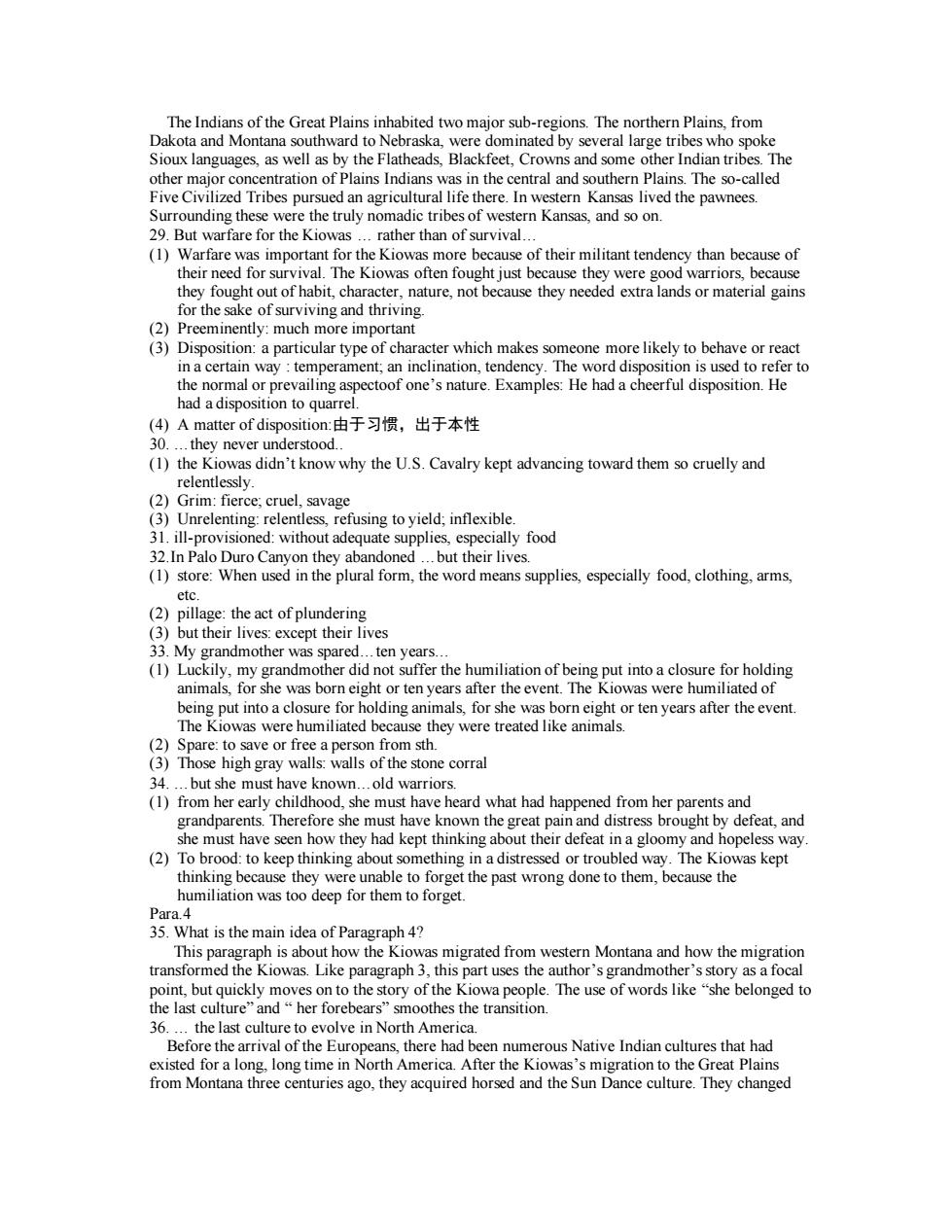
Sioux languages,as well as by the Flatheads.Blackfeet.Crowns and some other Indian tribes The other major concenration of Plain indians hereinye theecd Five Civiliz Tribes pu e ury no. rn Kansas,and 20 Rut ther the (1)Warfare was important for the Kiowas more because of their militant tendency than because of their need for survival.The Kiowas often fought just because they were good warriors,because th hcoetoutoh abit,cn (2)Pr (3)Disposition:a particular type of character which makes someone more likely to behave or react in a certain way:temperament;an inclination,tendency the no or preva ng 用A f dis po: 由于习惯,出于本性 the relentlessly ce;cruel,savage re without ade ng to ield inflexibl ally food but their lives (1)store:When used in the plural form,the word means supplies,especially food,clothing,arms, ing ared.ten years. ()Lckly,my grandmoerrethc for holding anima owas were num iliated of put into a ani or ten years after the even (2)Spare:to save or free a person from sth. ()Those high gray walls:walls of the stone corral but she must ha .old warriors what had from her par feat and (2)To brood:to keep thinking about something in a distressed or troubled way.The Kiowas kept thinking becaus they were ur ble to forget the past wrong done to them,because the Para deep for them to forge 35.What is the main idea of Paragraph 4? migrated from western Montana and how the migratior was ke paragraph art uses e author's grandmoth s story as a09 and“he The use of word ike belonged the last culture to evolve in north america Before the they acq ed ifer
The Indians of the Great Plains inhabited two major sub-regions. The northern Plains, from Dakota and Montana southward to Nebraska, were dominated by several large tribes who spoke Sioux languages, as well as by the Flatheads, Blackfeet, Crowns and some other Indian tribes. The other major concentration of Plains Indians was in the central and southern Plains. The so-called Five Civilized Tribes pursued an agricultural life there. In western Kansas lived the pawnees. Surrounding these were the truly nomadic tribes of western Kansas, and so on. 29. But warfare for the Kiowas . rather than of survival. (1) Warfare was important for the Kiowas more because of their militant tendency than because of their need for survival. The Kiowas often fought just because they were good warriors, because they fought out of habit, character, nature, not because they needed extra lands or material gains for the sake of surviving and thriving. (2) Preeminently: much more important (3) Disposition: a particular type of character which makes someone more likely to behave or react in a certain way : temperament; an inclination, tendency. The word disposition is used to refer to the normal or prevailing aspectoof one’s nature. Examples: He had a cheerful disposition. He had a disposition to quarrel. (4) A matter of disposition:由于习惯,出于本性 30. .they never understood. (1) the Kiowas didn’t know why the U.S. Cavalry kept advancing toward them so cruelly and relentlessly. (2) Grim: fierce; cruel, savage (3) Unrelenting: relentless, refusing to yield; inflexible. 31. ill-provisioned: without adequate supplies, especially food 32.In Palo Duro Canyon they abandoned .but their lives. (1) store: When used in the plural form, the word means supplies, especially food, clothing, arms, etc. (2) pillage: the act of plundering (3) but their lives: except their lives 33. My grandmother was spared.ten years. (1) Luckily, my grandmother did not suffer the humiliation of being put into a closure for holding animals, for she was born eight or ten years after the event. The Kiowas were humiliated of being put into a closure for holding animals, for she was born eight or ten years after the event. The Kiowas were humiliated because they were treated like animals. (2) Spare: to save or free a person from sth. (3) Those high gray walls: walls of the stone corral 34. .but she must have known.old warriors. (1) from her early childhood, she must have heard what had happened from her parents and grandparents. Therefore she must have known the great pain and distress brought by defeat, and she must have seen how they had kept thinking about their defeat in a gloomy and hopeless way. (2) To brood: to keep thinking about something in a distressed or troubled way. The Kiowas kept thinking because they were unable to forget the past wrong done to them, because the humiliation was too deep for them to forget. Para.4 35. What is the main idea of Paragraph 4? This paragraph is about how the Kiowas migrated from western Montana and how the migration transformed the Kiowas. Like paragraph 3, this part uses the author’s grandmother’s story as a focal point, but quickly moves on to the story of the Kiowa people. The use of words like “she belonged to the last culture” and “ her forebears” smoothes the transition. 36. . the last culture to evolve in North America. Before the arrival of the Europeans, there had been numerous Native Indian cultures that had existed for a long, long time in North America. After the Kiowas’s migration to the Great Plains from Montana three centuries ago, they acquired horsed and the Sun Dance culture. They changed
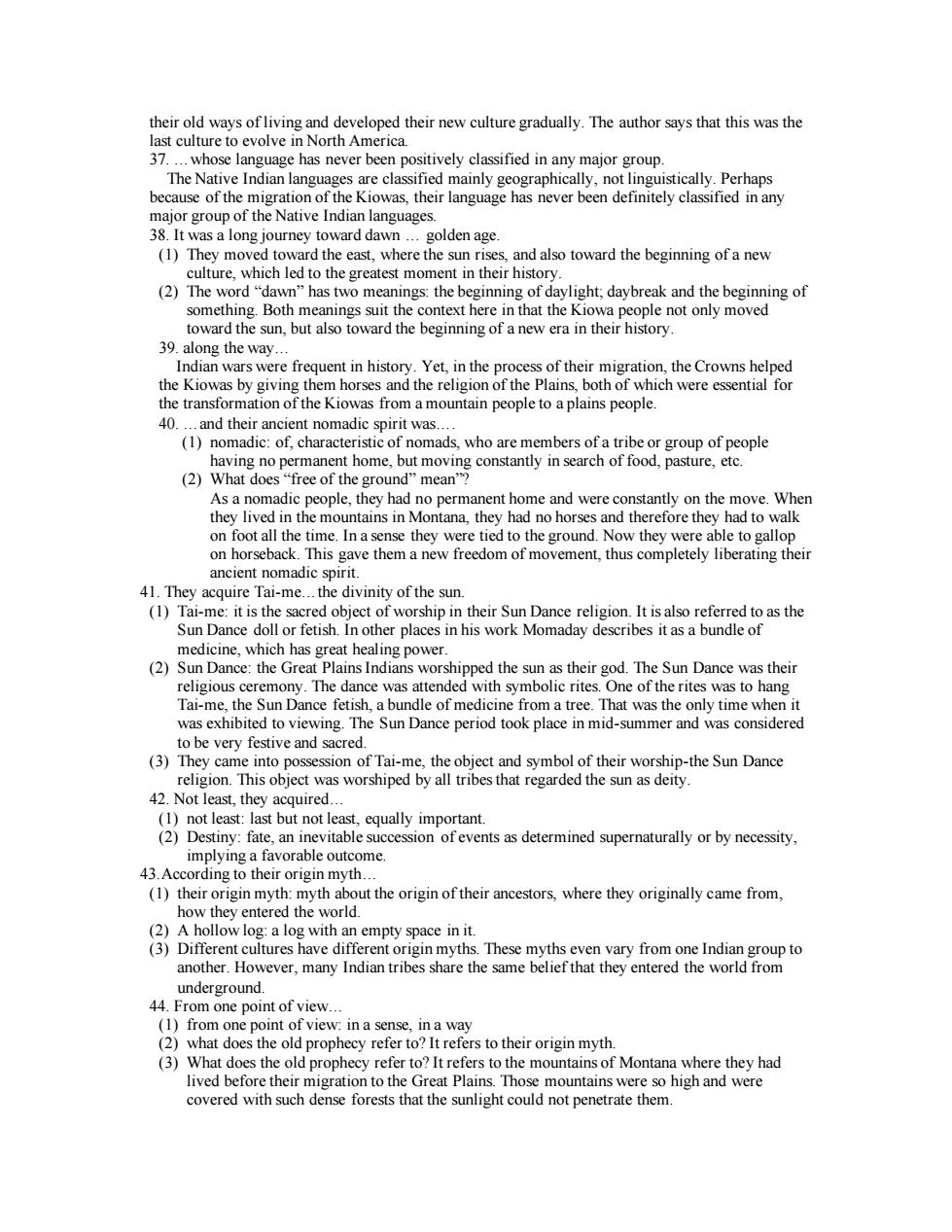
their old ways ofliving and developed their new cuture gradually.The author says that this was the 32cu e to evolven The Native Indian langu ohedangua s never ben definitely clasified in ay languages s a I lden age (1)Th and also toward the beginning of a new culture.which led to theg reatest moment in their histor (2)The word"dawn"has two meanings:the beginning of daylight,daybreak and the beginning of ing.Both me ings suit th context her in that the Kiow sun,b l 39 alon Indian wars were frequent in history.Yet,in the process of their migration,the Crowns helped eRbSmdheeeomrhePnsoh hich were essential for m a mountain people to a plains people and the spir having no permanent home,but moving constantly in (2)What does free of the ground"mean" dic people,they no permanent home and were constantly on the th d.Nnd on horseback.This gave them a new freedom of movement.thus completely liberating their ancient nomadic spirit 41 -me. ivinity of th e sun n Da the heir Mo nce rel 10 medicine.which has great healing (2)Sun Dance:the Great Plains Indians wors ipped the sun as their god.The Sun Dance was their .h ith symbolic rites ne of t rites was o hang wd. to be very festive and sacred. (3)They 42.Neligon. Tai-me,the object and symbol of their worship-the Sun Dance as worshiped by all tril s that regarded the sun as delt iavftennevuablealcesonotevenssdeterminedsupermaturalW favorable outcome. ding t ut the origin of their ancestors,where they originally came from. orld (2)A hollow log:a log with an empty space in it. (3)Diffe These myths sme blief that they th even vary from one India 44.Fund nt of vieu (1)from one point of view:in a sense.in a way e old prophecy refer to?It refers to their origin myth. old prophecy reter to?Itr sto the re ere they had covered with such dense forests that the sunlight could not penetrate them
their old ways of living and developed their new culture gradually. The author says that this was the last culture to evolve in North America. 37. .whose language has never been positively classified in any major group. The Native Indian languages are classified mainly geographically, not linguistically. Perhaps because of the migration of the Kiowas, their language has never been definitely classified in any major group of the Native Indian languages. 38. It was a long journey toward dawn . golden age. (1) They moved toward the east, where the sun rises, and also toward the beginning of a new culture, which led to the greatest moment in their history. (2) The word “dawn” has two meanings: the beginning of daylight; daybreak and the beginning of something. Both meanings suit the context here in that the Kiowa people not only moved toward the sun, but also toward the beginning of a new era in their history. 39. along the way. Indian wars were frequent in history. Yet, in the process of their migration, the Crowns helped the Kiowas by giving them horses and the religion of the Plains, both of which were essential for the transformation of the Kiowas from a mountain people to a plains people. 40. .and their ancient nomadic spirit was. (1) nomadic: of, characteristic of nomads, who are members of a tribe or group of people having no permanent home, but moving constantly in search of food, pasture, etc. (2) What does “free of the ground” mean”? As a nomadic people, they had no permanent home and were constantly on the move. When they lived in the mountains in Montana, they had no horses and therefore they had to walk on foot all the time. In a sense they were tied to the ground. Now they were able to gallop on horseback. This gave them a new freedom of movement, thus completely liberating their ancient nomadic spirit. 41. They acquire Tai-me.the divinity of the sun. (1) Tai-me: it is the sacred object of worship in their Sun Dance religion. It is also referred to as the Sun Dance doll or fetish. In other places in his work Momaday describes it as a bundle of medicine, which has great healing power. (2) Sun Dance: the Great Plains Indians worshipped the sun as their god. The Sun Dance was their religious ceremony. The dance was attended with symbolic rites. One of the rites was to hang Tai-me, the Sun Dance fetish, a bundle of medicine from a tree. That was the only time when it was exhibited to viewing. The Sun Dance period took place in mid-summer and was considered to be very festive and sacred. (3) They came into possession of Tai-me, the object and symbol of their worship-the Sun Dance religion. This object was worshiped by all tribes that regarded the sun as deity. 42. Not least, they acquired. (1) not least: last but not least, equally important. (2) Destiny: fate, an inevitable succession of events as determined supernaturally or by necessity, implying a favorable outcome. 43.According to their origin myth. (1) their origin myth: myth about the origin of their ancestors, where they originally came from, how they entered the world. (2) A hollow log: a log with an empty space in it. (3) Different cultures have different origin myths. These myths even vary from one Indian group to another. However, many Indian tribes share the same belief that they entered the world from underground. 44. From one point of view. (1) from one point of view: in a sense, in a way (2) what does the old prophecy refer to? It refers to their origin myth. (3) What does the old prophecy refer to? It refers to the mountains of Montana where they had lived before their migration to the Great Plains. Those mountains were so high and were covered with such dense forests that the sunlight could not penetrate them